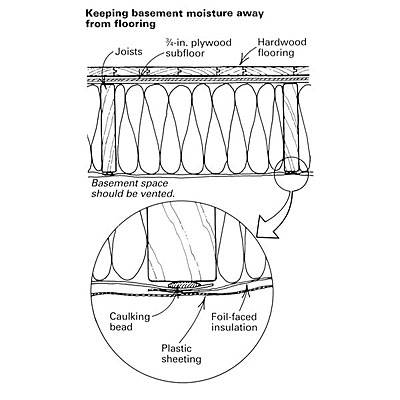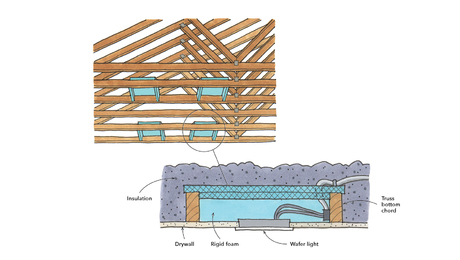Q:
I installed random-width select oak flooring in a home finished in May 1991. The deck is made of 2×10 Douglas-fir joists with 3/4-in. fir tongue-and-groove plywood subfloor covered with 15-lb. felt paper. The house has a full foundation with a concreteslab floor over 4 in. of stone and a 6-mil vapor barrier. I run dehumidifiers and the sump pump during the wettest time of the year. But during the spring and early summer, the flooring cups, especially the wider 5-in. boards. In November it flattens back out again. Can you tell me how to prevent this cupping?
Doug Underhill, Altamont, NY
A:
Paul Fuge of Plaza Hardwood in Santa Fe, New Mexico, replies: The situation you describe — a damp basement and a hydroscopic subfloor system — will always change with the seasons until you provide an alternative escape route for the moisture that inevitably comes into the basement and then moves through the floor.
First, let’s swallow the bitter pill of what should have been done before the plank flooring was installed. A vapor barrier under the plywood is the best choice. Putting plastic under the flooring rather than under the plywood is much less effective because the flooring nails penetrate the vapor barrier so many times. Back-priming plank flooring with cheap polyurethane also acts as an inexpensive, additional vapor barrier. Contrary to popular belief, 15-lb. felt paper is not a vapor barrier. It was designed to seal pine-board house sheathing from wind and weather. It is supposed to let water vapor pass through so that the siding won’t rot from moisture accumulating on the cold pine boards.
You need to prevent the moisture from moving from the damp basement up through the subfloor. Insulate between the 2×10 joists with foil-faced fiberglass batts. Be careful to lay the foil paper flat against the bottom edges of the joists. You could even put a bead of caulking along the bottom edge of the 2x10s to seal out basement moisture. I’d also put an additional layer of 6-mil plastic sheeting below the sealed batts.
My solution is the lesser of many evils. Normally, the vapor barrier on insulation is installed toward the living space, against the underside of the plywood. However, in your case the top priority is to stop extreme seasonal-moisture movement from your basement. With this arrangement your wood floor should stay warmer, and it should be more stable. Make sure the basement is vented, and keep that dehumidifier cranking.


























